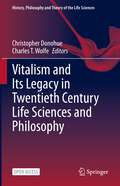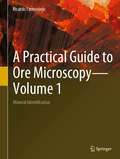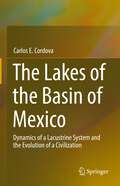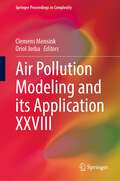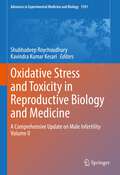- Table View
- List View
Manual of Biobank Quality Management
by Agnieszka Matera-Witkiewicz Joanna Gleńska-Olender Izabela Uhrynowska-Tyszkiewicz Małgorzata Witoń Karolina Zagórska Katarzyna Ferdyn Michał Laskowski Patrycja Sitek Błażej Marciniak Jakub Pawlikowski Dominik StrapagielThis pioneering handbook serves as an essential tool for any biobanking entity to create, implement and continuously improve their Quality Management System (QMS). Written in a concise and highly readable manner all biobanking related QMS aspects, ranging from legal aspects to safety matters, are addressed according to the best knowledge in compliance with the dedicated Biobanks ISO standards. Following a practical approach by making use of FAQ and common practice sections this book guides the readers through this complex field in an easy-to understand way.The guidelines are convergent not only with ISO 20387:2018 Biotechnology - Biobanking - General requirements for biobanking but also with ISO 9001:2015, ISO 19011:2018, ISO 27000:2014, and ISO 27002:2013. Furthermore, they are compatible, among others with the recommendations of the Organization for Economic Cooperation and Development (OECD), IARC, and ISBER Best Practices. Aimed at both biobank employees and other stakeholders (e.g. public bodies, political bodies, hospitals, pharmaceutical industry, funders) at any level of experience the book serves as valuable source for self-education and teaching. The manual complies to the principles of responsibility, openness, and transparency and can be used by any biobanking unit regardless of the biological material the biobank operates with and independent of their associated biobank network. On behalf of a group of specialists and experts in the area of biobanking, regarding Quality Management Systems (QMS), Ethical, Legal and Societal Issues (ELSI) and IT solutions, the authors present with this book a significant achievement based on activities within the project, European Research Infrastructure BBMRI-ERIC „Quality Standards for Polish Biobanks” Handbook (QSPB).
Smart Biolabs of the Future (Advances in Biochemical Engineering/Biotechnology #182)
by Sascha Beutel Felix LenkThis book reviews the advances in data gathering and processing in the biotech laboratory environment, and it sheds new lights on the various aspects that are necessary for the implementation of intelligent laboratory architecture and infrastructure. Smart technologies are increasingly dominating our everyday lives and have become an indispensable part of the industrial environment. The laboratory environment, which has long been rather conservative, has also set out to adapt smart technologies with regards to Industry 4.0 and the Internet of Things (IoT) for the laboratory. Due to the heterogeneity of the existing infrastructure and the often complex work processes, standardization is slow, e.g. to implement device interfaces or standardized driver protocols, which are urgently needed to generate standardized data streams that would be immanent for post-processing of data.Divided into 9 chapters, this book offers an authoritative overview of the diverse aspects in the generation and recording of uniform data sets in the laboratory, and in the processing of the data and enabling seamless processing towards machine learning and artificial intelligence. In the first part of the book, readers will find more about high throughout systems, automation, robotics, and the evolution of technology in the laboratory. The second part of the book is devoted to standardization in lab automation, in which readers will learn more about some regulatory aspects, the SiLA2 standards, the OPC LADS (Laboratory and Analytical Device Standard), and FAIR Data infrastructure
The Food Security, Biodiversity, and Climate Nexus
by Mohamed Behnassi Himangana Gupta Mirza Barjees Baig Ijaz Rasool NoorkaThis volume is the outcome of an international cooperation between 73 scientists, experts, and practitioners from many countries, disciplines, and professional areas. As a part of a series of CERES publications, the volume attempts to contribute to the scientific debate about the food–biodiversity–climate nexus by developing a comprehensive region-specific and broader global understanding of the linkages between these areas, especially in the context of Global South. Instead of providing only modern science-based solutions for the nexus related challenges, the volume covers case studies that present mixed solutions, offering the use of traditional ecological knowledge in combination with modern science for both resilience and sustainability. This is increasingly instrumental in shaping the needed response options regarding the economic, social, and environmental future of the world. Based on a multi-regional and cross-sectoral analysis, the approach consists of: assessing the different natural and anthropogenic factors currently affecting ecosystems and their services, especially the impacts of climate change; highlighting the different linkages between the state of biodiversity and food systems in many contexts and scales; and exploring the various response mechanisms to effectively manage the implications of such linkages. Most chapters provide inputs for future relevant research and policy agendas.
Vitalism and Its Legacy in Twentieth Century Life Sciences and Philosophy (History, Philosophy and Theory of the Life Sciences #29)
by Charles T. Wolfe Christopher DonohueThis Open Access book combines philosophical and historical analysis of various forms of alternatives to mechanism and mechanistic explanation, focusing on the 19th century to the present. It addresses vitalism, organicism and responses to materialism and its relevance to current biological science. In doing so, it promotes dialogue and discussion about the historical and philosophical importance of vitalism and other non-mechanistic conceptions of life. It points towards the integration of genomic science into the broader history of biology. It details a broad engagement with a variety of nineteenth, twentieth and twenty-first century vitalisms and conceptions of life. In addition, it discusses important threads in the history of concepts in the United States and Europe, including charting new reception histories in eastern and south-eastern Europe. While vitalism, organicism and similar epistemologies are often the concern of specialists in the history and philosophy of biology and of historians of ideas, the range of the contributions as well as the geographical and temporal scope of the volume allows for it to appeal to the historian of science and the historian of biology generally.
Case Studies in Experimental Physics: Why Scientists Pursue Investigation (Synthesis Lectures on Engineering, Science, and Technology)
by Ronald Laymon Allan FranklinThis book addresses the pursuit and further investigation of experimental results by analyzing classic examples from physics. The authors concentrate on the investigation of experimental results by examining case studies from the history of 20th and 21st century physics. Discussions on the discovery of parity nonconservation, the rise and fall of the Fifth Force, the search for neutrinoless double β decay, supersymmetry and the expansion of the Standard Model, and measurements of the anomalous magnetic moment of the muons are provided. Experimental results may achieve acceptance to the point that even well known principles, such as conservation of energy and quantization, lose their status as accepted. Such principles and their options are treated on an equal footing as being pursuit worthy even though there is no plausible explanation as to why and how they might have failed.
Numerical Methods for Mixed Finite Element Problems: Applications to Incompressible Materials and Contact Problems (Lecture Notes in Mathematics #2318)
by Jean Deteix Thierno Diop Michel FortinThis book focuses on iterative solvers and preconditioners for mixed finite element methods. It provides an overview of some of the state-of-the-art solvers for discrete systems with constraints such as those which arise from mixed formulations.Starting by recalling the basic theory of mixed finite element methods, the book goes on to discuss the augmented Lagrangian method and gives a summary of the standard iterative methods, describing their usage for mixed methods. Here, preconditioners are built from an approximate factorisation of the mixed system.A first set of applications is considered for incompressible elasticity problems and flow problems, including non-linear models.An account of the mixed formulation for Dirichlet’s boundary conditions is then given before turning to contact problems, where contact between incompressible bodies leads to problems with two constraints.This book is aimed at graduate students and researchers in the field of numerical methods and scientific computing.
A Practical Guide to Ore Microscopy—Volume 1: Mineral Identification
by Ricardo CastroviejoThis book offers a guide to the microscopic study of metallic ores with reflected light. It combines a rigorous approach with an attractive and easy-to-follow format, using high-quality calibrated photomicrographs to illustrate the use of color for ore identification. The ore identification methodology is updated with systematic color analysis and the application of new multispectral reflectance datasets, which offer an efficient tool for automated ore characterization. In addition, the first volume of this two-part work discusses the essential gangue minerals.Readers will gain familiarity with the method as they follow its application to over 200 selected minerals, comprising the most important ore (≈150) and gangue (≈50) minerals, which are described in the text. Each entry includes an explanatory text with corresponding color photomicrographs for each of the most common microscope settings, preceded by a table summarizing the ore’s main properties, and followed by spectral information in the visible and near-infrared ranges (specular reflectance values from 370 to 1000 nm). Some uncommon, strategic ores, e.g. columbotantalite (“coltan”) and monazite, receive particular attention or are described for the first time with reflected light.Lastly, the book presents a learning strategy for beginners and students. The approach is essentially practical, focusing on the development of observation skills, including self-checking through proposed practical tasks. In addition, the traditional use of determinative tables is critically reviewed and updated.This book is part of a two-volume work. The second volume focuses on intergrowths/textural analysis and interpretation, as well as computer-vision-based automation and applications to ore processing/geometallurgy.The intended audience includes professionals and engineers dealing with mineral resources, as well as postgraduate students. The book also provides lifelong learning support for freelancers and a valuable reference resource for practical university teaching.
Pharmaceutical Nanobiotechnology for Targeted Therapy (Nanotechnology in the Life Sciences)
by Hamed Barabadi Ebrahim Mostafavi Muthupandian SaravananThe field of nanotechnology for targeted therapy initiated more than decade ago has grown fast and interest is increasing. Given the importance of the field for targeted drug and gene delivery systems, there are a large number of laboratory investigations today researching nanobiomaterials for diagnostic and therapeutic applications. Because of the ability of scientists to load nanoparticles with any agent, interest continues to grow and technology in this arena is rapidly evolving. These emerging nanobiomaterials-based medicines can overcome the disadvantages of traditional medicines by target-oriented and site-specific delivery of precise medicines (immunotherapeutic agents, chemotherapeutic agents, diagnostic agents, and so on). Pharmaceutical Nanobiotechnology for Targeted Therapy presents an updated overview of recent advancements in the field of pharmaceutical nanobiotechnology and nano-based drug and gene delivery systems. This comprehensive knowledge will allow researchers to discover innovative nanobiomaterials for targeted therapeutics. The chapters deal with various emerging nanobiomaterials for targeted therapeutic delivery systems and the writing is in a style that is easily disseminated and in a manner that can be readily adopted as sources for new and further studies. This book should be useful for researchers and professionals from academia and industry working in the field of nanotechnology, nanobiotechnology, as well as in the field of pharmaceutical nanotechnology. It should also be useful to those interested in a range of disciplines from material science, chemistry, molecular biology, polymer chemistry, and many more interdisciplinary areas.
The Lakes of the Basin of Mexico: Dynamics of a Lacustrine System and the Evolution of a Civilization
by Carlos E. CordovaThis book is a review of research on the prehistoric and historic evolution of the Basin of Mexico’s lacustrine systems. Based on this review, the book presents a model of long and short-term natural lacustrine dynamics as the basis for understanding the processes of human adaptation and transformation of the aquatic ecosystems of the Basin of Mexico. Although only remains of the former lakes exist, the book stresses the importance of the knowledge of the former natural and cultural history of the lakes. In this sense, the book addresses the misconceptions and misinterpretations of the lakes that still exist in the literature and the media and that do not reflect the real nature of the lakes in the past. Therefore, the book attempts to not only feed into the local knowledge of the lakes, but also contribute to the worldwide knowledge of lacustrine dynamics and human populations that lived in and around them. The book should be of interest to geographers, geologists, archaeologists, natural historians and environmental scientists, civil engineers, city planners and those involved in the management of natural resources.
Atmospheric Chemistry in the Mediterranean Region: Volume 1 - Background Information and Pollutant Distribution
by François Dulac Stéphane Sauvage Eric HamonouThis two-volume set provides an extensive review of the abundant past and recent literature on the atmospheric chemistry in the Mediterranean region. The books document the experience gained on the atmospheric composition over the Mediterranean basin and close areas after almost six decades of studies, starting from early studies of radioactive aerosol fallouts and intense desert dust events in the 1960s, aerosol samples collected during oceanographic cruises in the early 1980s and including discoveries from subsequent surface monitoring stations, intensive campaigns, satellite climatologies, laboratory studies, as well as chemistry-transport and climate models. Through ten thematic sections, the authors examine the sources and fates of atmospheric pollutants over the Mediterranean basin and what we know about their major impacts on air quality and health, on the radiative budget and climate, on marine chemistry and biogeochemistry. This overview not only considers the full cycle of both aerosol and reactive gases including emissions, transport, transformation, and sinks, but also addresses the main impacts of the regional atmospheric chemistry. The volumes are an initiative from the ending ChArMEx project that has federated many studies on those topics in the past decade, and update the scientific knowledge by integrating the ChArMEx and non-ChArMEx literature. The books are contributed by a large pool of well-known authors from the respective fields, mainly from France and Greece, but also from fourteen other countries. All chapters have been peer-reviewed by international scientific experts in the corresponding domains. Volume 1 provides background information on the Mediterranean atmosphere, and focuses on the synoptic and dynamic conditions affecting pollutant concentrations over the Mediterranean basin, aerosol concentrations and variability, and reactive gas concentrations and variability. The targeted audience is the academic community working on atmospheric chemistry and its impacts on climate, air quality and marine biogeochemistry, especially teams having a special interest in the Mediterranean region, which includes many countries and institutes worldwide.
Recent Developments in Statistics and Data Science: SPE2021, Évora, Portugal, October 13–16 (Springer Proceedings in Mathematics & Statistics #398)
by Regina Bispo Lígia Henriques-Rodrigues Russell Alpizar-Jara Miguel De CarvalhoThis volume presents a collection of twenty-five peer-reviewed articles carefully selected from the contributions presented at the XXV Congress of the Portuguese Statistical Society (2021). Containing state-of-the-art developments in theoretical and applied statistics, the book will be accessible to readers with a background in mathematics and statistics, but will also be of interest to researchers from other scientific disciplines (e.g., biology, economics, medicine), who will find a broad range of relevant applications.
Progress in Botany Vol. 83 (Progress in Botany #83)
by Ulrich Lüttge Francisco M. Cánovas María-Carmen Risueño Christoph Leuschner Hans PretzschWith one volume each year, this series keeps scientists and advanced students informed of the latest developments and results in all areas of the plant sciences. This latest volume includes reviews on plant physiology, biochemistry, genetics and genomics, forests, and ecosystems.
Air Pollution Modeling and its Application XXVIII (Springer Proceedings in Complexity)
by Clemens Mensink Oriol JorbaThis book states that current developments in air pollution modeling are explored as a series of contributions from researchers at the forefront of their field. This newest contribution on air pollution modeling and its application is focused on local, urban, regional and intercontinental modeling; long-term modeling and trend analysis; data assimilation and air quality forecasting; model assessment and evaluation; aerosol transformation. Additionally, this work also examines the relationship between air quality and human health and the effects of climate change on air quality.This work is a collection of selected papers presented at the 38th International Technical Meeting on Air Pollution Modeling and its Application, held in Barcelona, Spain, Oct 18–22, 2021. The book is intended as reference material for students and professors interested in air pollution modeling at the graduate level as well as researchers and professionals involved in developing and utilizing air pollution models.
Plant Molecular Farming: Applications and New Directions (SpringerBriefs in Plant Science)
by Kaiser Iqbal Wani Tariq AftabMolecular farming is a biotechnological approach that includes the genetic adjustment of agricultural products to create proteins and chemicals for profitable and pharmaceutical purposes. Plant molecular farming describes the manufacture of recombinant proteins and other biologically active product in plants. This approach depends on a genetic transformation of plants that can be accomplished by the methods of stable gene transfer, such as gene transfer to nuclei and chloroplasts, and unstable transfer methods like viral vectors. The requirement for recombinant proteins in terms of quality, quantity, and diversity is increasing exponentially This demand is traditionally met by recombinant protein construction technologies and the engineering of orthodox expression systems based on bacteria or mammalian cell cultures. However, majority of developing countries cannot afford the high costs of medicine derived from such existing methods. Hence, we need to produce not only the new drugs but also the cheaper versions of those already present in the market. Plant molecular farming is considered as a cost-effective technology that has grown and advanced tremendously over the past two decades. This book summarizes the advances and challenges of plant molecular farming for all those who are working on or have an interest in this rapidly emerging area of research.
Amazon Fruits: An Ethnobotanical Journey (Ethnobiology)
by Nigel SmithThis is the first comprehensive listing of Amazon fruits from an ethnobotanical perspective. This detailed book covers 50 botanical families, 207 species, in the Amazon including how the people of each region use them. It is lavishly illustrated with high-quality photographs taken by the author, an extensive list of references, and Dr. Smith’s latest, meticulous research. This book should be a foundational work for scholars working in the plant sciences, researchers in ethnobotanical studies, and general interest scholars seeking more detailed information on the latest research by a leading scientist in the Amazon.
Forest Hydrology and Catchment Management: An Australian Perspective
by Leon BrenThis book provides scientific evidence to underline the notion that forests offer the most reliable water catchments in the natural environment. The unique Australian ecosystem provides valuable information on the water yields and hydro-ecology of forests. Insights can be transferred to other climate zones and conditions. In this second edition, the author puts a particular focus on the most prominent challenges of our time, in relation to water management. Ground salinity, climate change, and droughts have all been newly added to this updated edition. One of the most important concepts is highlighting the accumulated contribution of smaller catchments and minor streams. Finally, readers will also get information on the economic dimension of water management. With its incisive, disciplined, and quantitative (and occasionally humorous) approach, this book helps scientists, students, and regulators to understand water-driven conflicts and offers guidance on management.
Modern Applications of Lanthanide Luminescence (Springer Series on Fluorescence #19)
by Ana de Bettencourt-DiasThis volume builds upon the successful book Lanthanide Luminescence published in the Springer Series on Fluorescence in 2011. Since its publication, the field of lanthanide spectroscopy and the areas in which the light emission properties of the f-elements are used have experienced substantial advances. The luminescence properties of lanthanide ions make them unique candidates for a myriad of optical applications. This book highlights and reviews the latest research in areas ranging from luminescence thermometry to imaging, sensing and photonic applications of these fascinating elements. Each chapter provides a comprehensive introduction to a specific area of application of lanthanide luminescence and extensively reviews seminal papers and current research literature. Given its interdisciplinary scope, the book appeals to scientists and advanced students in physics, chemistry and materials science interested in compounds and materials with optical properties.
An Introduction to Large-Scale Tropical Meteorology (Springer Atmospheric Sciences)
by Vasubandhu MisraThis upper-undergraduate/graduate-level textbook introduces students to large-scale tropical climate circulation and its variations, covering their fundamental aspects and our current understanding of how they are impacted in a warming world. From this volume, readers will gain an understanding of tropical climate variability from the meso- to planetary scale. Uniquely, equal emphasis is placed on atmospheric and oceanic processes of tropical phenomena. The book will appeal to senior undergraduate and graduate students across geoscience disciplines, including in meteorology, oceanography, geography, hydrology, and environmental science.
Roger Bacon and the Incorruptible Human, 1220-1292: Alchemy, Pharmacology and the Desire to Prolong Life (Palgrave Studies in Medieval and Early Modern Medicine)
by Meagan S. AllenThis book examines the Franciscan alchemist Roger Bacon’s (1220-1292) interest in the role of alchemy in medicine, and how this interest connected with the thirteenth-century milieu in which he was writing. Though twelfth-century Latin alchemy had largely been concerned with transmuting base metals into noble ones, Bacon believed that the natural principles taught in alchemy would be better used in medicine. In an age where many physicians were theorizing about ways to prevent the effects of aging, Bacon held that combining alchemy and humoral medicine would allow one to extend their life by decades, even centuries. By examining Bacon’s alchemical, medical, and mathematical works, this book argues that Bacon combined a number of sources to create a unique plan for prolonging human life. His understanding of disease and aging was ultimately Galenic in nature, and his understanding of how pharmaceuticals work can be traced back to his mathematical theories, especially that of the multiplication of species. The book provides a new system for organizing Bacon’s alchemically-produced medicines, and explains what Bacon saw as the difference between each, and how they could have different physiological effects. Bacon is situated within the thirteenth-century contexts in which he was writing – that of the university-educated and newly professionalized medical practitioners, who were invested in finding ways to extend human life; and the Franciscan order, with their understanding of the innate goodness of the physical body, the resurrection, and corporeal union with God. Filling a major lacuna in scholarship on the history of medieval medical writings, this book provides vital reading for historians of medicine, pre- and early modern European science, and medieval philosophy and religion.
Cost-efficient Wastewater Treatment Technologies: Engineered Systems (The Handbook of Environmental Chemistry #118)
by Mahmoud Nasr Abdelazim M. NegmThis is the second of two volumes that together provide a comprehensive overview of the current sustainable and low-cost wastewater treatment technologies applied in communities that lack the financial and technical resources needed for an environmental, disease prevention and health nexus. This book reviews engineered wastewater treatment technologies and discusses their application in regard to greenhouse gas emissions, natural resource utilization, land-use, and energy and water savings. The chapters from expert contributors cover topics such as aerobic and anaerobic biological treatments, chemical treatments and precipitation, and disinfection. Readers will also learn about simplified and low-energy wastewater treatment plants, strategies for wastewater reuse, and nanotechnologies for wastewater environmental management. The feasibility regarding time and cost of implementing such technologies is also discussed in this book, and particular attention is given to the removal of conventional and emerging pollutants, toxicants, and heavy metals. Given the breadth and depth of its coverage, the book offers an invaluable source of information for researchers, students and environmental managers alike.
Quality Innovation and Sustainability: 3rd ICQIS, Aveiro University, Portugal, May 3-4, 2022 (Springer Proceedings in Business and Economics)
by João Carlos de Oliveira Matias Carina Maria Oliveira Pimentel João Carlos Gonçalves dos Reis Joana Maria Costa Martins das Dores Gilberto SantosThis book provides various approaches to complex industrial problems in sustainability, operations management and industrial engineering. It features in-depth research presented by academics, scholars, researcher and professionals at the 3rd International Conference on Quality Innovation and Sustainability (ICQIS) in the fields of quality, innovation, sustainability and operations management. It addresses topics such as quality management systems; Lean and Six Sigma; information systems for quality management; data management and industry 4.0; innovative solutions for quality challenges; environmental quality policies and standards; circular economy and life cycle costing; occupational health; safety and welfare in manufacturing; and smart systems, among others.
Cost-efficient Wastewater Treatment Technologies: Natural Systems (The Handbook of Environmental Chemistry #117)
by Mahmoud Nasr Abdelazim M. NegmThis is the first of two volumes that together provide a comprehensive overview of the current sustainable and low-cost wastewater treatment technologies applied in communities that lack the financial and technical resources needed for an environmental, disease prevention and health nexus.This book reviews natural wastewater treatment technologies and traces the current challenges in wastewater management and sustainability. Divided into 4 themed parts, the chapters from expert contributors cover topics such as simplified and low-energy natural treatment facilities, bioremediation and biotechnology for green future, environmental impact assessment of wastewater reuse, wastewater management and sustainability for irrigation, high-performance and cost-effective biosorbents for heavy metals removal, and eco-friendly nanomaterials for wastewater environmental management. The readers will discover essential recommendations for improving natural treatment systems to withstand emerging contaminants, namely, endocrine disruption chemicals, surfactants, personal care products, pesticides, and pharmaceuticals. Readers will also find valuable guidelines to ensure sustainable and innovative solutions for wastewater treatment in the light of climate change, resource, demand, and funding challenges.Given the breadth and depth of its coverage, the book offers an invaluable source of information for researchers, students and environmental managers alike.
Values, Identity, and Sustainable Development in Africa (Sustainable Development Goals Series)
by Ezra Chitando Eunice KamaaraThis book contends that Africa’s sustainable development must be built on African identity and values. Contributors reflect of the role of values in Africa’s effort to overcome poverty, the focus of SDG 1. The volume reflects on how indigenous values such as Ubuntu constitute a critical resource in addressing poverty. It reiterates the importance of positioning the response to poverty in Africa on the continent’s own, home grown values. Contributors also interrogate how values such as integrity, hard work, tolerance, solidarity, respect and others serve to position Africa strategically to overcome poverty. The volume focuses on how values can help Africa to overcome challenges such as corruption, violence, intolerance, competitive ethnicity, xenophobia, misplaced priorities and others. It provides fresh and critical reflections on the role of values and identity in anchoring Africa’s development in the light of SDG 1.
Clean Energy Investments for Zero Emission Projects: An Analysis on How to Reduce the Carbon Footprint (Contributions to Management Science)
by Hasan Dinçer Serhat YükselThis contributed volume analyses and discusses how atmospheric carbon emissions can be prevented using carbon capture and removal technology and how renewable energies can be used to reduce carbon emissions. Both approaches have their disadvantages. First of all, both involve high costs. Secondly, both require the use of advanced technology. As a result, many countries continue to use fossil fuels. The book seeks to address these problems by identifying strategies to increase countries’ use of clean energy. The authors discuss the dilemmas of zero emission and competition in the energy industry and illustrate cross-country applications of the current trends in the form of zero-emission business projects.
Oxidative Stress and Toxicity in Reproductive Biology and Medicine: A Comprehensive Update on Male Infertility Volume II (Advances in Experimental Medicine and Biology #1391)
by Shubhadeep Roychoudhury Kavindra Kumar KesariVolume Two advances the exploration of the fundamental principles of oxidative stress and toxicity on male (and female) reproduction. It includes the advances in research on male reproductive health, the impact of environmental factors, the protective measures using bioactive compounds and traditional medicines, and how to limit toxic exposure. It includes coverage of: Oxidative stress and male infertilityEnvironmental stressors and sexual healthHeavy metals, pesticides, fine particle toxicity and male reproductionProtective measures against oxidative stress in gametes/embryos by using bioactive compounds/phytomedicines in Assisted Reproductive Technology (ART)Role of reactive oxygen species on female reproductionRadiation and mutagenic factors affecting the male reproductive systemBoth volumes provide a comprehensive look at the most basic concepts and advanced research being conducted by world famous scientists and researchers in male infertility and reproduction.



